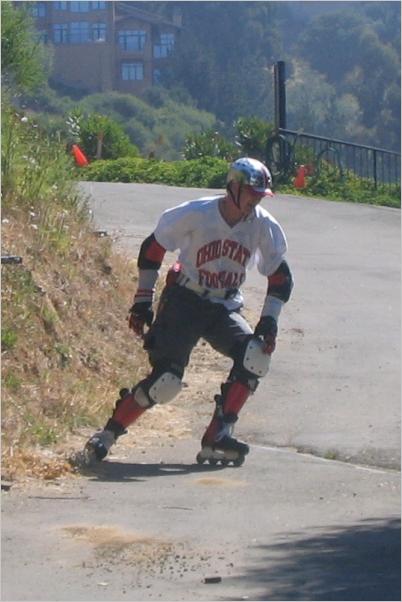This week's tip:
Managing Different Road Surfaces
How to skate safely on just about anything
By Tim Monroe

Tim Monroe skates a rough road in Oakland.
Photo courtesy: Tim Monroe
Most of the time, we get to choose our skate routes and so naturally we opt for clean, unbroken pavement with little traffic or other obstacles.
But sometimes there’s only one way to go.
That’s how it was for me when I set out to skate the entire city of Boston: every street — all 850 miles of them — in every one of the city’s 21 neighborhoods.
Along the way, I encountered the full range of road surfaces, including asphalt, cobblestone, dirt and even metal (think of those large plates covering roadwork or the metal pedestrian ways on a bridge).
I also rolled through generous portions of mud, sand, ice, snow, oil, leaves and twigs and had to negotiate assorted hazards, including sewer covers, potholes and lane markers (both painted and applied).
You name it, I skated it.
And it taught me a lot — especially about how to contend with assorted road conditions.
I could write a book about it. But until then, here are some of my favorite strategies:
Soften the blow
The most important thing I can tell you about skating variable, and at times unfriendly, road surfaces is this: sometimes you will fail. Sometimes, you will lose your balance and fall. (This is the Prime Rule of Skating: You will fall down.)
Sometimes, something will trip you up — a patch of sand, a pebble, a stick … whatever — and you will come crashing down.
In some rare cases, you may even go down on purpose to avoid a worse fate, like picking up too much speed on a downhill.
Since falling is inevitable, there is really only one question: How do you minimize the damage?
My answer is twofold. First, I armor up with lots of protective gear. At minimum, I wear knee and elbow pads, wrist guards and helmet.
Second, I make sure to practice using my gear so that when I do fall, I can let the pads take the brunt of the impact.
The best way to do this is to practice falling.
Find a nice patch of lawn or soft ground. Then, from a standing position, drop down on your knee pads. Repeat until you can do it comfortably.
Next, practice dropping down onto your knee pads and your wrist guards. The muscle memories you create with these drills will help you when the real thing happens.
As you do these drills, you may find that your pads are too loose and slip out of place when you hit the ground. If so, tighten them up.
I don't know how many times I've limped home with road rash on my knees or elbows simply because my pads were too loose.
...
Tim Monroe (a.k.a. Tristo) is an avid inline skater who has managed to avoid major injury despite decades of urban skating in cities like San Francisco, Oakland and Boston. In May 2013, he finished his skate of all 850 miles of Boston streets. In 2006, he completed his skate of all 831 miles of Oakland streets, earning a commendation from the City Council, which praised him for his "unique and extraordinary physical accomplishment." His exploits have been heralded in children's books and documentary films. When he's not skating, he might be working as a software engineer for Apple. Tim currently splits his time between Cambridge, MA and Oakland, CA.
comments powered by Disqus